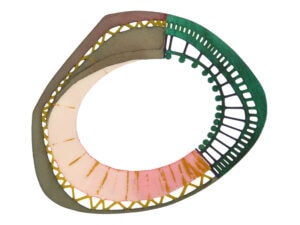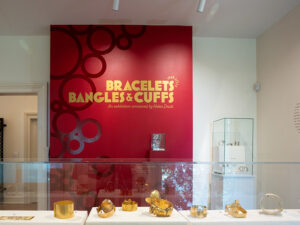Since 1997 Elise Winters has been collecting polymer jewelry with the intention of establishing a permanent collection in an American museum, along with an online archive that celebrates polymer jewelry in all its forms. Having gone through all the stages and roles of collector – acquiring objects, establishing her collection’s identity, working with experts and eventually dispersing the collection to museums – AJF thought it would be a good idea to interview Winters about her experiences. Damian Skinner interviewed her by email and here’s what they discussed.
Damian Skinner: In talking about the idea of this interview, you expressed some reservations that you’re not a typical collector. How would you describe a ‘typical collector’ and what makes you different?
Elise Winters: What I meant was that I am not a typical AJF collector. My collection was media based and while most of it was polymer jewelry, it did include a number of important pieces that were not jewelry. When I began looking to place my collection in museums, my goals were also media based. And I thought those goals would make my experiences quite different from other AJF members. I was very clear about my goals but, to be honest, I’m not so clear about what goals another jewelry collector might have. In my opinion, having clarity about one’s goals is critical to the success of such an endeavor.
How would you describe your goals as a collector? Did it take you a while to realize not only what you were trying to achieve, but also the best way to do it?
I understood my goals as a collector very early on. Almost as soon as I began working with polymer myself, I realized that there was some exceptional work being done with the medium by several artists and that their work was grossly undervalued. At that time my resources were limited, but I determined to purchase a significant piece from each of my ‘heroes’ before their prices rose to a level where I could no longer afford them.
In 1996, I purchased the first piece in my collection. It was a necklace by Cynthia Toops and she delivered it to me at a small conference. I remember wearing the necklace and people approaching me to ask what I had paid for it. My reply was, ‘Much more than I can afford, but way less than it is worth.’ I was shy to admit I had paid $600 for the piece – probably a record-breaking price for polymer at the time. That necklace is now in the collection of the Museum of Art and Design in New York City.
My goals in ‘gifting’ my collection took much longer to evolve. The starting point was probably in 2005, in a discussion with my husband about our ‘DINK’ (Dual Income No Kids) status. My husband, Woody Rudin, has collected personally signed first editions of contemporary literature for almost 50 years. We were both concerned that our collections would end up in some yard sale with 50-cent price tags stuck on them. Woody’s solution was an easy one. He would choose to leave his collection and a part of our estate to the 92nd St Y in New York City. My solution was a fantasy: if only there were a similar institution for polymer to which I could give my collection. But none existed. That’s when I first hatched the idea of giving my collection as a cornerstone for establishing a significant polymer collection within an appropriate museum.
My first step was to join AJF so that I could begin learning what collectors did and thought about their collections. Up to this point I’d never thought of myself as a collector. Over the next several years I did extensive research and networking: attending lectures and conferences; talking to dozens of collectors, curators, artists and museum officials at all levels. Throughout that period my goals shifted, expanded and refined. And at the same time I homed in on very specific objectives. In the end, I accomplished much more than I had initially hoped.
Tell me about the processes you used to manage your collection as it grew. How did you store the objects? Record them? Gather information about them?
You might think that if you are willing to give away work to a museum, they will graciously accept whatever is offered. However, because of the costs of storage, research, preservation, restoration and the complexity of deaccessioning work, museum curators are very cautious about what works they acquire – and thus take responsibility for.
Since polymer was a totally new and unfamiliar material, I realized I could offer a ‘value-added’ feature if the collection came with complete and accurate documentation. Every piece was given an identification number, photographed and measured. That information, along with the artist’s name, title of the work and date, as well as acquisition date and cost, were entered into a master database. I adapted an artist-verification questionnaire which I’d gotten from Cindi Strauss, created one for each of the significant pieces in the collection and uploaded them to Google Documents. Beyond the basics, these questionnaires asked for details about materials, processes, relevance of the particular piece to their body of work, as well as exhibition and publication history. Artists were then asked to complete those questionnaires. Once a museum selected a piece for their permanent collection, their registrar was given access to the appropriate Google document.
Physically managing and storing all the work was a challenge. Some precautions were taken to protect and handle the work carefully, but nothing extraordinary. Truth be told, it was a shock to be asked to don white gloves at the Terra Nova exhibition when I adjusted one of my own pieces, remembering how I tossed it around my studio. Once a piece crosses over the line into a museum’s permanent collection, it takes on a different life. No one will ever hold that baby in their tender loving hands again.
There are lots of stereotypes about collectors and why they do what they do. Having gone through the process of being a collector in quite a defined, conscious sense – including giving up your ‘babies’ to the care of the museum – what would you say drives the collecting impulse? What have you learned about yourself and your motivations?
I know there have been studies about the collecting impulse but I’m not sure how I fit into any of those profiles. Most collectors, I expect, have some investment in possessing the objects of their collection and in displaying them to others. I rarely wore the polymer jewelry of others but I did enjoy showing the work to students when the occasion was right. Some of the works hung on the walls of my home. As my own personal collection made its way into museums, surprisingly I did not feel separation anxiety, rather a joy of achievement. Perhaps without being aware of it, I was collecting history, more than objects, right from the beginning.
Tell me a little bit about polymer – like, what it is, how long it has been around, why it is overlooked. What constitutes really outstanding work in that medium?
The particular form of polymer which we artists use is a thermoplastic. It is a man-made modeling material which comes in colors and remains pliable until it is cured at about 300 degrees. It is marketed under the brand names Premo and Fimo. Many people refer to it as polymer ‘clay,’ but I never use the term clay because it suggests that the object is heavy and fragile. In fact, objects made from polymer are both lightweight and durable, often even flexible.
The material was an accidental by-product of 1930s German plastics research. Eventually it was marketed as a children’s toy. Pier Voulkos and several other early polymer artists began making jewelry with it in the mid-1970s. (Rachel Carren’s essay on the early history of polymer art appears in the Racine Art Museum’s recent publication, Terra Nova: Polymer Art at the Crossroads. It is the most comprehensive and most accurate account on this topic.)
There are so many reasons why polymer was overlooked initially. The answer to this one question could take an entire essay on its own. A friend recently commented to me that ‘polymer is really easy to use, but really hard to master.’ So, early on, it was considered a kid’s plaything and anyone with time on their hands could crank out ‘bubble gum’ beads by the millions. Since there was no tradition, there were also no standards. And initially, the market place was flooded with polymer products lacking in both skill and design.
Outstanding work in polymer is no differrent from outstanding work in any other medium. It demonstrates mastery of skills, good design and speaks with a personal voice. Here again I would refer you to RAM’s book Terra Nova to see examples.
You mention that there was no tradition for polymer jewelry and thus, no standards. I assume that your project has been about establishing standards – trying to create a tradition and preserve and record what seems to you to be the high points of the material so far. What’s involved in inventing a tradition in this way and was it difficult to do?
This is an ongoing process. My goals were simply to broaden the audience and to educate curators and collectors about the medium – what it is and what high-quality work looks like. Through meetings with curators, through the Terra Nova exhibition at RAM and with the companion book, more was accomplished than I’d ever imaged. We were able to gather artists, collectors and curators in Racine for a symposium during the opening weekend of the show. One of the outgrowths of that symposium was the formation of various task forces to address many of the issues of concern to professionals working in the medium. Of course, the Polymer Art Archive will continue preserving the historic record.
But my approach had been very haphazard. Rachel Carren is now at the helm and in her capable hands, with her background in art history, the documentation will, no doubt, become much more thorough. She will be working with RAM to preserve important ephemera as well. A curriculum task force is now forming, as well as groups concerned with product advocacy, professional development and guildlines. Those new missions are in the hands of others. And I hope that RAM will become the center for preserving the materials we amass, and provide continuity for those that follow.

Damian Skinner: In talking about the idea of this interview, you expressed some reservations that you’re not a typical collector. How would you describe a ‘typical collector’ and what makes you different?
Elise Winters: What I meant was that I am not a typical AJF collector. My collection was media based and while most of it was polymer jewelry, it did include a number of important pieces that were not jewelry. When I began looking to place my collection in museums, my goals were also media based. And I thought those goals would make my experiences quite different from other AJF members. I was very clear about my goals but, to be honest, I’m not so clear about what goals another jewelry collector might have. In my opinion, having clarity about one’s goals is critical to the success of such an endeavor.
How would you describe your goals as a collector? Did it take you a while to realize not only what you were trying to achieve, but also the best way to do it?
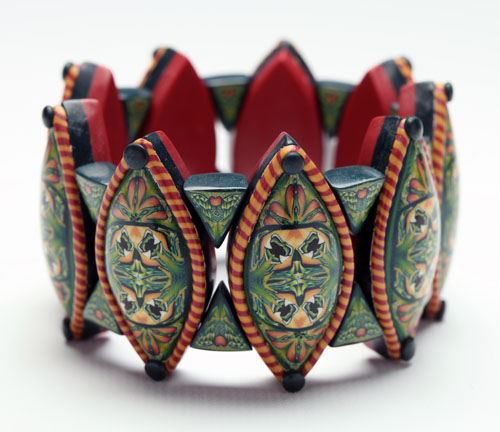
In 1996, I purchased the first piece in my collection. It was a necklace by Cynthia Toops and she delivered it to me at a small conference. I remember wearing the necklace and people approaching me to ask what I had paid for it. My reply was, ‘Much more than I can afford, but way less than it is worth.’ I was shy to admit I had paid $600 for the piece – probably a record-breaking price for polymer at the time. That necklace is now in the collection of the Museum of Art and Design in New York City.
My goals in ‘gifting’ my collection took much longer to evolve. The starting point was probably in 2005, in a discussion with my husband about our ‘DINK’ (Dual Income No Kids) status. My husband, Woody Rudin, has collected personally signed first editions of contemporary literature for almost 50 years. We were both concerned that our collections would end up in some yard sale with 50-cent price tags stuck on them. Woody’s solution was an easy one. He would choose to leave his collection and a part of our estate to the 92nd St Y in New York City. My solution was a fantasy: if only there were a similar institution for polymer to which I could give my collection. But none existed. That’s when I first hatched the idea of giving my collection as a cornerstone for establishing a significant polymer collection within an appropriate museum.
My first step was to join AJF so that I could begin learning what collectors did and thought about their collections. Up to this point I’d never thought of myself as a collector. Over the next several years I did extensive research and networking: attending lectures and conferences; talking to dozens of collectors, curators, artists and museum officials at all levels. Throughout that period my goals shifted, expanded and refined. And at the same time I homed in on very specific objectives. In the end, I accomplished much more than I had initially hoped.
Tell me about the processes you used to manage your collection as it grew. How did you store the objects? Record them? Gather information about them?
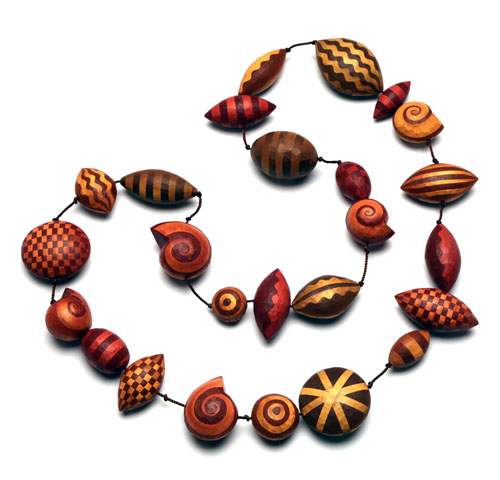
Since polymer was a totally new and unfamiliar material, I realized I could offer a ‘value-added’ feature if the collection came with complete and accurate documentation. Every piece was given an identification number, photographed and measured. That information, along with the artist’s name, title of the work and date, as well as acquisition date and cost, were entered into a master database. I adapted an artist-verification questionnaire which I’d gotten from Cindi Strauss, created one for each of the significant pieces in the collection and uploaded them to Google Documents. Beyond the basics, these questionnaires asked for details about materials, processes, relevance of the particular piece to their body of work, as well as exhibition and publication history. Artists were then asked to complete those questionnaires. Once a museum selected a piece for their permanent collection, their registrar was given access to the appropriate Google document.
Physically managing and storing all the work was a challenge. Some precautions were taken to protect and handle the work carefully, but nothing extraordinary. Truth be told, it was a shock to be asked to don white gloves at the Terra Nova exhibition when I adjusted one of my own pieces, remembering how I tossed it around my studio. Once a piece crosses over the line into a museum’s permanent collection, it takes on a different life. No one will ever hold that baby in their tender loving hands again.
There are lots of stereotypes about collectors and why they do what they do. Having gone through the process of being a collector in quite a defined, conscious sense – including giving up your ‘babies’ to the care of the museum – what would you say drives the collecting impulse? What have you learned about yourself and your motivations?

Tell me a little bit about polymer – like, what it is, how long it has been around, why it is overlooked. What constitutes really outstanding work in that medium?

The material was an accidental by-product of 1930s German plastics research. Eventually it was marketed as a children’s toy. Pier Voulkos and several other early polymer artists began making jewelry with it in the mid-1970s. (Rachel Carren’s essay on the early history of polymer art appears in the Racine Art Museum’s recent publication, Terra Nova: Polymer Art at the Crossroads. It is the most comprehensive and most accurate account on this topic.)
There are so many reasons why polymer was overlooked initially. The answer to this one question could take an entire essay on its own. A friend recently commented to me that ‘polymer is really easy to use, but really hard to master.’ So, early on, it was considered a kid’s plaything and anyone with time on their hands could crank out ‘bubble gum’ beads by the millions. Since there was no tradition, there were also no standards. And initially, the market place was flooded with polymer products lacking in both skill and design.
Outstanding work in polymer is no differrent from outstanding work in any other medium. It demonstrates mastery of skills, good design and speaks with a personal voice. Here again I would refer you to RAM’s book Terra Nova to see examples.
You mention that there was no tradition for polymer jewelry and thus, no standards. I assume that your project has been about establishing standards – trying to create a tradition and preserve and record what seems to you to be the high points of the material so far. What’s involved in inventing a tradition in this way and was it difficult to do?
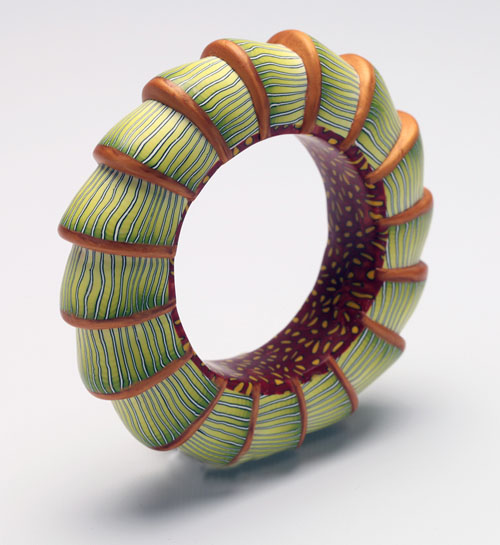
But my approach had been very haphazard. Rachel Carren is now at the helm and in her capable hands, with her background in art history, the documentation will, no doubt, become much more thorough. She will be working with RAM to preserve important ephemera as well. A curriculum task force is now forming, as well as groups concerned with product advocacy, professional development and guildlines. Those new missions are in the hands of others. And I hope that RAM will become the center for preserving the materials we amass, and provide continuity for those that follow.

